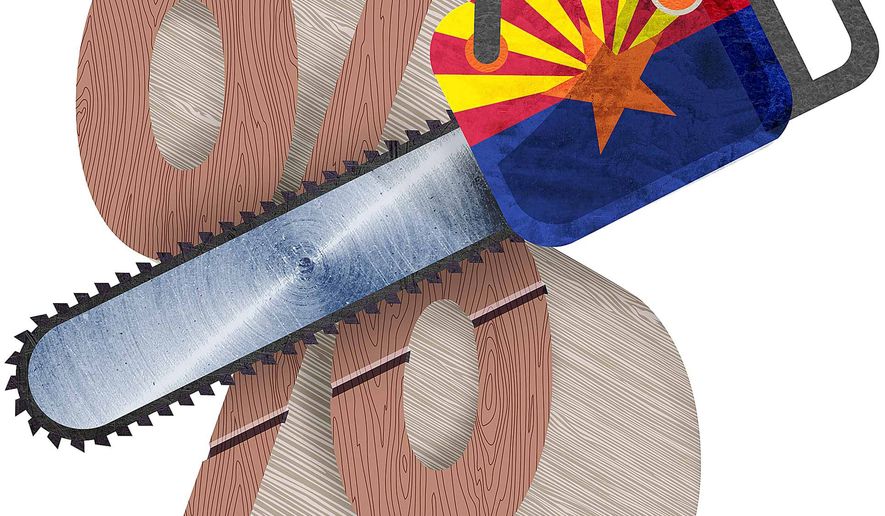OPINION:
Fresh off a decisive re-election win, Arizona Gov. Doug Ducey, and his allies in the state legislature have some big decisions to make about what’s next for the hardworking taxpayers of Arizona. Many states spent a significant amount of time, and legislative capital, during 2018 addressing the recent federal tax changes under the Tax Cuts and Jobs Act (TCJA), which was signed into law by President Donald Trump last December. However, Arizona has not yet decided on this “tax conformity” issue, and some sources say the clock might be ticking, as a narrowly divided House and Senate taking office in Phoenix next year.
How did federal tax reform cause this major policy inflection point for states? When federal changes to the tax code — particularly definitions of adjusted gross income (AGI) in the case of Arizona — “broaden the tax base,” they also expand taxable income at the state level. If state lawmakers conform with the federal changes, in many cases, states see a windfall of unbudgeted and ongoing revenue. When it comes to state budgeting, this is something of a “blue moon” scenario, as the last major federal tax reform occurred more than 30 years ago under President Ronald Reagan.
As a result of conforming and receiving the resulting revenue boost, states like Idaho, Missouri, Iowa and Georgia were able to use that opportunity and pass along the windfall to state taxpayers by enacting historic tax relief and rate reductions this year. Their economies will be stronger for it. Even Bernie Sanders’ Vermont took part in the tax-cutting action and used the unexpected revenue from the TCJA to reduce tax burdens.
Not conforming to the federal changes could be very problematic for small businesses across the Grand Canyon State. “By not acting, policymakers are allowing more income tax complexity to beset Arizona individuals — and businesses, large and small,” said Chad Heinrich, Arizona State Director for the National Federation of Independent Business (NFIB). “According to the SBA Office of Advocacy, 99.4 percent of Arizona businesses are considered small and these businesses employ one million workers in our state,” he said.
Additionally, if Arizona lawmakers simply conform with federal tax changes and leave town without reducing tax burdens elsewhere, taxpayers would be on the hook for a tax increase, and government would significantly grow. That’s why so many states took the extra step and returned the TCJA tax reform windfall to state taxpayers — and in the process, made their state economies more competitive. These 2018 state tax reforms continue to build on a trend, as states look for ways to become more competitive. All told, in the past five years more than 30 states have significantly reduced their tax burdens.
The Grand Canyon State has long enjoyed the benefits of a competitive economic policy climate and the resulting economic growth it has provided. In the annual Rich States, Poor States: ALEC-Laffer State Economic Competitiveness Index, which ranks the states based on economic policy factors that affect growth, Arizona’s economic outlook ranks fifth best in the nation in 2018. The state’s long track record in keeping a free market policy framework has paid major dividends for taxpayers and the economy.
Arizona has been a huge winner in the race for human capital. Over the past decade, the Grand Canyon State has gained more than 372,000 Americans, on net from the other 49 states. It is a basic, but essential lesson from our system of competitive federalism across states that people “vote with their feet” towards locations that provide them with more economic opportunity and greater upward mobility.
However, past achievement is no guarantee of future success — just look at California, a once booming state, where several decades of tax and spend policies have driven millions of hardworking taxpayers and businesses away. Outside of California, however, the Southwest is generally a very competitive region. Utah, which once again cut income tax rates due to the TCJA effect this year, has retained the top economic outlook in America for all 11 editions of the Rich States, Poor States index. Nevada has long been a strong competitor, since it keeps overall tax burdens low and avoids a personal income tax altogether. It’s going to take smart policy choices to keep Arizona competitive with neighbors like these. Luckily, Arizona taxpayers dodged a major threat when a proposed “millionaires’ tax” ballot measure, which would have roughly doubled the top personal income tax rate, was kicked off the 2018 ballot by the Arizona Supreme Court.
The untold story of federal tax reform is the golden opportunity it has provided policymakers in our 50 laboratories of democracy and innovation. Only time will tell, but Arizona has a real chance to boost its already solid economic outlook and stay competitive with the many states that have already taken advantage of the federal windfall. Absent tax reform, Arizona faces the threat of falling behind in the race for economic competitiveness in an extremely competitive region, simply by standing still.
• Jonathan Williams is chief economist at the American Legislative Exchange Council and vice president of its Center for State Fiscal Reform.




Please read our comment policy before commenting.